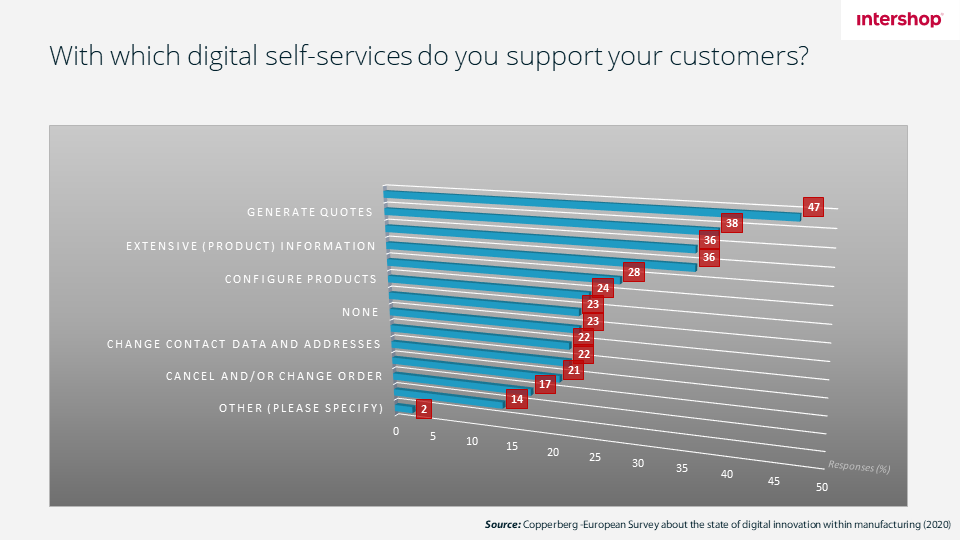A single place where everyone can find the information they need, specifically for them—it sounds perfect. And it can be, if all systems are aligned so you can provide a 360° view for each customer.
The demand for online self-service in B2C and B2B
B2C self-service features
You’ve purchased a product or service but still have questions— Does that sound familiar? Many B2C webshops give you the option of logging into your personal account to view your order history, delivery information, warranties, and invoices as well as to arrange and track any necessary repairs or returns.
B2B self-service needs
In B2B, the online self-service needs of customers are even greater and more crucial, depending on the type of product involved. For example, there is a need for composition and origin information, installation manuals and videos, a list of matching spare parts, maintenance contracts, safety certificates, custom documents, images (including 3D images), design drawings, and service tickets. Those who still lack this kind of digital service are playing catch-up because other companies are already identifying opportunities to boost customer satisfaction, improve efficiency, and increase sales.
Convenience through self-service
My account features in webshops
Every large webshop has a “My account” component that caters to the needs of consumers. This is usually not very complex because online pure-players often have just one sales channel, a single customer environment, and terms and conditions that apply to everyone.
Complexity of B2B buyer journeys
Many B2B webshops also have a “My account” section with basic functionality. But the B2B buyer journey is more complex due to multiple roles of buying committees, internal processes and budgets, contracts with suppliers and much more.
For instance, B2B customers want to be able to manage their orders (and reordering) themselves, use their own article numbers for orders, take internal budgets and authorization thresholds into account, have access to different service levels to be able to guarantee availability, and have constant access (online and offline) to their order status and history.
Insights from B2B decision-makers on self-services
Intershop and Copperberg recently questioned leading B2B decision-makers on their ambitions and successes in personalizing the B2B buyer journey. Here’s what they say about digital self-services:

Extensive product details and general information pay for themselves
Providing extensive product details and general information is vital in B2B. Especially for more complex products or machines, detailed overviews are essential because customers want to be 100% certain they are choosing the right replacement part. This saves a lot of search time when those eventually have to be ordered and prevents them, for example, from making mistakes affecting the productivity of their machines and missing customer delivery times, causing distress with their customers.
Phone calls and e-mails about warranties, delivery times, and repairs are restricted to office-hours and time-consuming. They can become an enormous expense for both customer and supplier. This is especially true when customer service starts asking questions about type numbers and order dates, or which dealer or branch handled a purchase.
Or, even worse, imagine the cost if the production process grinds to a halt because the wrong part was delivered. With a customer portal, you can handle important contact scenarios digitally and personalized, provide a higher level of security and service, and prevent a lot of confusion.
Cross- and upselling
At the same time, a customer portal is a veritable marketing gold mine. The data you receive can easily be leveraged for personalized cross- and upselling. You can also use a customer portal to draw attention to supplementary services, such as maintenance contracts and personalized offers.
Some companies have found that revenues (and, more importantly, profit margins) from selling spare parts and providing services are actually higher than from the initial sale of their heavy machines. For many manufacturers they are even responsible for the largest part of the company profits.
Naturally, all processes have to be designed accordingly to guarantee the highest life-time customer value. If customers need to search through a huge and complex web shop for the right replacement parts, there’s a chance they will ultimately give up or switch to a competitor.
By contrast, if customers can immediately see what parts they need in a personalized customer portal, view warranty information, and identify the average lifespan of parts, it’s really easy for them to purchase these products. Customers are prepared to pay more for a service like this. A high level of service and in-depth product knowledge are essential here.
A powerful e-commerce platform is a must
An e-commerce platform that merges marketing, sales, customer service data and processes provides the flexibility and stability you need to differentiate yourself from your competitors by customer centricity.
This means that all your touchpoints are integrated, and always provide personalized and consistent up-to-date information. On a side note, such platforms allow both direct sales or a team of sales reps to do their job better - because digital sales channels can be linked to ERP, CRM, purchasing and back-office systems.
Next steps in digital evolution
In short: with the right commerce platform, you can hook up virtually any system to create personalized customer portals and offer the agility to quickly respond to changing customer needs and marketing opportunities. Whatever your company’s ambitions are, your digital commerce solution should be a constant companion in all your next steps of digital evolution. Grow-as-you-go and take it with you!
If you want to know how a customer portal can look like and how you can combine commerce, CRM and AI in it, we have a webinar ready to watch:








